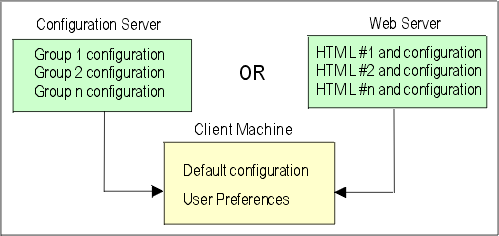


Users are able to run sessions using the default configuration that you define. Users can modify this default configuration according to personal preference. These personalized changes are stored on users' local machines separate from any default session configuration information (assuming you gave them permission to save changes in the Deployment Wizard). When you change the default configuration, users will automatically receive updates without losing any personalized changes. If you lock a particular session property, you will override any changes the user may have made to that particular property.
Note: In certain cases, the location where local user preferences are stored has changed since the release of Host On-Demand V6.0. These changes in location are in response to the need to support the limited access rights of Windows Restricted Users. In cases where the locations have changed, if a user has existing preferences from a prior release of Host On-Demand, those preferences will be automatically migrated to the new location. The specific instances where the location of preferences has changed is noted in red in the chart below.
In the chart, the value username usually denotes the operating system
userid currently logged on. However, with Netscape 4.x on Windows, it represents
the Netscape profile id, which is not necessarily linked to the Windows login
ID. The profile id has a default value called "default," although users
can create their own profiles with Netscape's profile manager.
| Platform and Browser | Host On-Demand Versions 7, 8 and 9 |
|---|---|
| Windows 98 & IE
Windows 98 & Netscape 4 Windows 98 & Netscape 6 |
\Windows\Java\username\HODData
\Netscape\Users\username\HODData \Windows\username\HODData |
| Windows 2000/XP & IE
Windows 2000/XP & Netscape 4 Windows 2000/XP & Netscape 6 |
\Documents&Settings\username\HODData
\Netscape\Users\username\HODData \Documents&Settings\username\HODData |
| Windows NT & IE
Windows NT & Nestcape 4 Windows NT & Netscape 6 |
\WINNT\Profiles\username\HODdata
\Netscape\Users\username\HODData \WINNT\Profiles\username\HODData |
| OS/2 and Netscape 4
OS/2 and Netscape 6 |
\Netscape\Users\username\HODData
\java13\JRE install dir\HODData |
| UNIX and Netscape 4
UNIX and Netscape 6 |
/home/username/.netscape/HODData
/home/username/HODData |